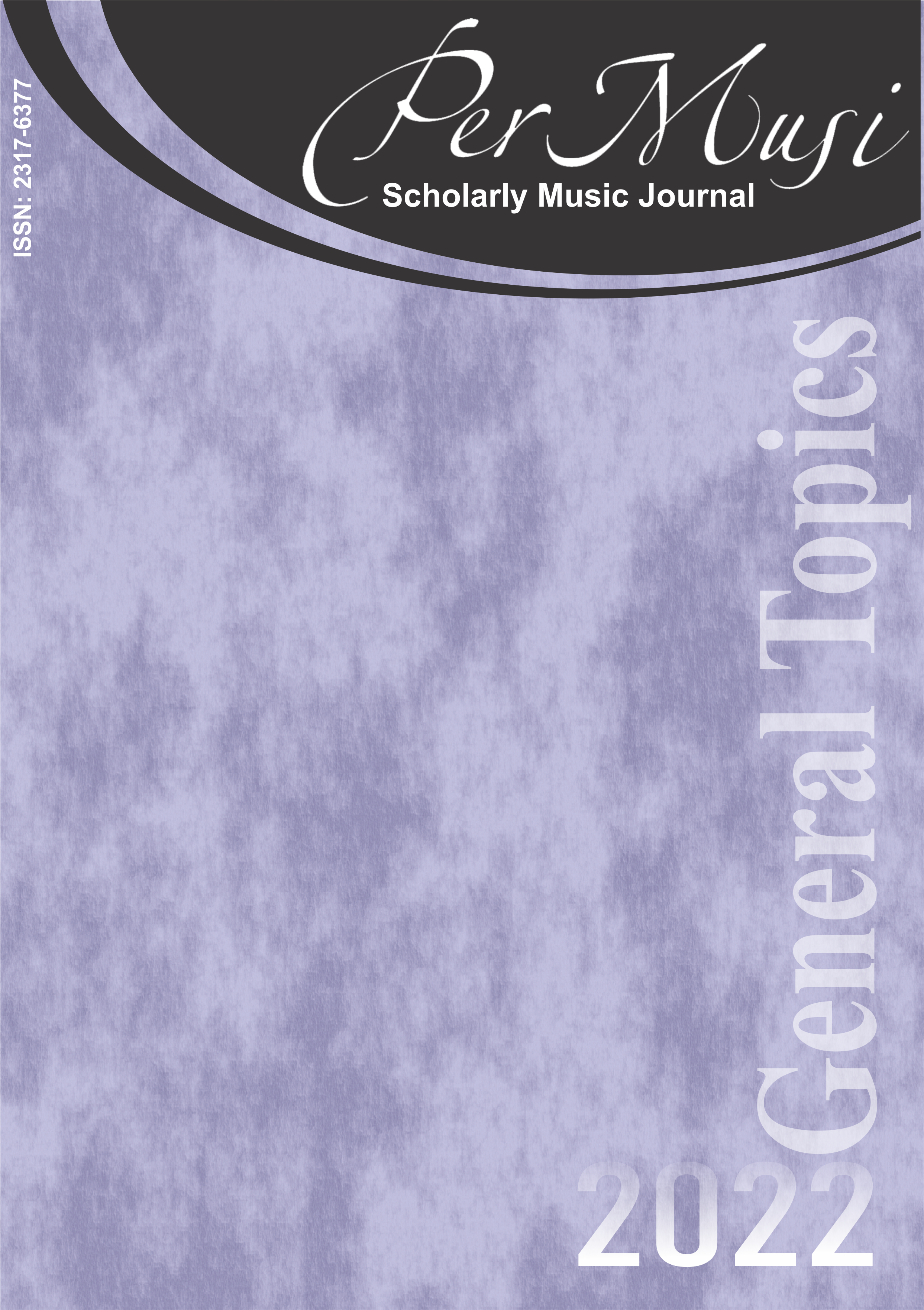Orient-Occident de Fulchignoni-Xenakis
analizar la relación entre música e imagen
DOI:
https://doi.org/10.35699/2317-6377.2022.48275Palabras clave:
Xenakis, Orient-Occident, Música electroacústica, Banda sonoraResumen
La película Oriente-Occidente, dirigida por Enrico Fulchignoni con música de Iannis Xenakis (aún no disponible comercialmente) es, en general, sólo mencionada a través de la versión de concierto homónima de la música de Xenakis. Esta indisponibilidad de la obra cinematográfica es lamentable, primero porque se trata de un documental con excelente contenido y excelente calidad visual y, segundo, porque demuestra la extraordinaria capacidad de imaginación sonora de Xenakis. Esta imaginación se expresa a través de ideas musicales (compositivas), pero también a través de la forma en que Xenakis ilustra y comenta las imágenes de la película. El artículo
Referencias
Andersson, Barry. 2015. The DSLR Filmmaker’s Handbook, Indianapolis, Indiana: John Wiley & Sons, Inc.
Block, Bruce. 2014. Composer ses images pour le cinéma. Paris: Eyrolles.
Chanan, Michael. 2007. “Rouch, Music, Trance.” In Building Bridges: The Cinema of Jean Rouch, editado por Joram ten Brink. 87-95. Londres: Wallflower.
Chion, Michel. 2003. Pierre Henry. Paris: Fayard.
Delalande, François. 1997. “Il faut être constamment un immigré”. Entretiens avec Xenakis. Paris: Buchet-Chastel/INA-GRM.
Freire, Marcius. 2011. Documentário: ética, estética e formas de representação. São Paulo: Annablume.
Fulchignoni, Enrico. 1981. “Sur Orient-Occident”. In Regards sur Iannis Xenakis, 257-262. Paris: Stock.
Gauthier, Guy. 1995. Le documentaire, um autre cinéma. Paris: Nathan.
Graff, Séverine. 2011. “ ‘Cinéma-vérité’ ou ‘cinéma direct’: hasard terminologique ou paradigme théorique ?”, Décadrages 18: 31-46. doi: https://doi.org/10.4000/decadrages.215
Guillaume, Paul. 1979. Psychologie de la forme. Paris: Flammarion.
Harley, James. 2002. “The Electroacoustic Music of Iannis Xenakis”. Computer Music Journal 6 (1): 33-57.
Jay, Emmanuelle. 2020. Le montage - Technique et esthétique: fiction, documentaire, série, nouvelles écritures. Malakoff: Armand Colin.
Lindenmuth, Kevin J. 2011. Réaliser son premier documentaire. Paris: Eyrolles.
Revault d’Allonnes, Fabrice. 1991. La Lumière au Cinéma. Paris: Éditions Cahiers du Cinéma.
Schaeffer, Pierre; Reibel, Guy; Ferreyra, Beatriz. 1967 (1998). Solfège de l’objet sonore. Trois microsillons d’exemples sonores illustrant le Traité des objets musicaux et présentés par l’auteur. Paris: INA-GRM, 1967.
Solomos, Makis. 2009. “Orient-Occident. From the film version to the concert version”. In Iannis Xenakis: Das elektroakustische Werk, editado por Ralph Paland, Christoph von Blumröder, 118-134. Viena: Verlag Der Apfel, Signale aus Köln 14.
Villain, Dominique. 1984. L’œil à la caméra. Paris: Éditions de l’Etoile.
Xenakis, Iannis. 1992. Formalized Music. Stuyvesant: Pendragon Press.
_________________. 1997. Electronic Music. EMF/INA-GRM, EMF CD 003.
_________________. 2008. Electronic music 2: Polytope de Cluny, Hibiki Hana Ma, Neg-ale for “Vasarely”. Mode Records, mode 203.
Descargas
Publicado
Número
Sección
Licencia
Derechos de autor 2024 Per Musi

Esta obra está bajo una licencia internacional Creative Commons Atribución 4.0.

Excepto cuando se indique lo contrario, el contenido de este sitio está sujeto a una Licencia Creative Commons - Atribuição 4.0 Internacional.












